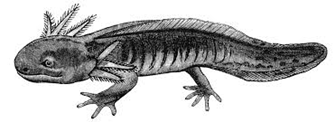What’s So Cool About the Axolotl?
What’s So Cool About the Axolotl?
I think I’ve mentioned before that I’m a volunteer docent at Connecticut’s Beardsley Zoo in Bridgeport, CT. As a docent, I get to talk to a lot of interesting people about all our fascinating animals!
Guests might come to the Zoo for any number of reasons – to see the Andean bear, or the Amur leopards, the prairie dogs, the bison, the red panda, the historic greenhouse or any of the baby animals (people love them all!). But what I heard one day surprised me.
“Excuse me,” a guest said, “but can you tell me where to find the Axolotl? It’s the only reason we came to the Zoo today!”
Don’t get me wrong. It’s not that I don’t think the Axolotl isn’t a fascinating creature; it most certainly is! But it’s not the most cuddly animal we have, many people have never heard of it, and it’s a salamander – not the most well-loved of animals. So I decided to dive into information about the Axolotl. It didn’t take long for me to realize why people might be enthralled by it: it’s incredibly cute and has inspired characters in Pokemon and Animal Crossing, made an appearance in Minecraft and has even been featured as a Google Doodle.
So I wanted to share with you all the highlights of what I learned.
What’s so cool about the Axolotl? Legend has it that the Axolotl is the Aztec god of fire and lightning, Xolotl, who disguised himself as a salamander to avoid being sacrificed. But that’s not all that makes them a little bit god-like. They have an impressive ability to regenerate lost limbs and stay “young” throughout their lives.
With a happy little face and frilly gills, it’s like the amphibian version of a puppy. This cuteness is caused by literally not growing up properly. Their youthful traits include feathery gills sprouting from their heads like a mane, webbed feet, a dorsal fin that runs down the length of their body, and a tail. Though they keep their gills, adult Axolotls also have functional lungs and can breathe through their skin. And as if being forever-youthful didn’t make them cute enough, their mouths are upturned in a permanent Mona Lisa smile.
Most salamanders undergo metamorphosis from their totally aquatic larval form to their mostly terrestrial adult forms. Not the Axolotl! It’s one of the salamander species that retains all of its larval features — external gills and a fin along its back —

It can also regenerate almost any part of its body, including its limbs, eyes and even parts of its brain, which makes it of great interest to scientists studying regenerative biology.
Why is it endangered? It’s only found in Lake Xochimilco and Lake Chalco, near Mexico City. Unfortunately, Lake Chalco was drained by humans to avoid flooding (the ultimate loss of habitat), and Lake Xochimilco is severely diminished, having been reduced to mostly canals. Add to that pollution, and the introduction of invasive predators that eat baby salamanders, and the result is a species that is Critically Endangered with just 50 to 1,000 remaining in the wild.
What Color Are They? You may see pictures of axolotls that are either brownish gray or white and pink. Wild axolotls are dark, while captive animals are often white with pink gills.
Lifespan: Despite being able to regenerate, they do not live forever. Their lifespan is between 10 and 15 years.
For information about what Mexico is doing to help save the Axolotl, visit npr.org. Here you’ll also find a link to information about how to can adopt an Axolotol.


I like your blog. Keep on writing. Great job!